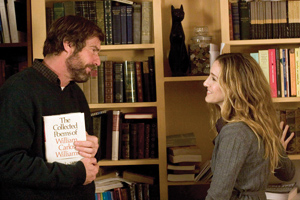Harold and Kumar Escape from Guantanamo Bay
Rating: 3/5
Starring: John Cho, Kal Penn, Rob Corddry
Directed by: Jon Hurwitz, Hayden Schlossberg
There is a separation moment in “Harold and Kumar Go to White Castle,” one that divides those who then and there buy into the movie’s silliness from those who simply cannot do so. Anyone who has seen it remembers-it is the moment that the two upper-middle-class stoner heroes climb onto the back of a cheetah in an attempt to ride it to safety. At this point the audience (the ones who aren’t high, at least) must decide whether they will accept the movie’s ridiculous premise and embrace the simple pleasures found in a pot comedy with a brain and a heart.
But from someone who laughed himself to tears when Harold and Kumar’s makeshift Battle Cat took off into the New Jersey foliage, I must say that the characters’ unlikely second outing, “Harold and Kumar Escape from Guantanamo Bay,” doesn’t ever have that moment. But it manages quite a few chuckles and perhaps a belly laugh or two. I’m just not sure that I ever bought it.
“Guantanamo Bay” picks up right where “White Castle” left off. Roommates Harold and Kumar have bought two plane tickets to Amsterdam. They are on a mission to find Harold’s new lady love Maria, and to spend a week in the weed capital of the world. At the airport, they run into Kumar’s ex who is all set to marry a rich, Brooks Brothers-wearing, cushy-government-job-holding jerk. (How come all the coolest girls fall for these guys?) Kumar is visibly shaken, not only by the feelings he still has for this girl but by the realization that he has done nothing with his life in the time since they broke up.
He brushes off his sadness by reminding himself that he is on his way to a vacation visiting his green, memory-depleting lover. In fact, he’s so impatient to get a taste of his favorite herbal remedy that he breaks out a high tech water pipe on the plane. Of course when a passenger sees a brown guy trying to light up a tubular device with flashing lights in the bathroom, his insistence that what he carries is only a bong falls on deaf ears.
They quickly escape from the inept guards at Gitmo and start the long journey to Texas to find Kumar’s ex so that they can use her boyfriend’s connections to get out of their jam.
The humor of Harold and Kumar is built mostly on cultural ignorance and twisted expectations. The pot humor is certainly a part of it, but most of the jokes are about institutional racism, either on the part of the characters or the audience. The original played mostly with stereotypes of Asians, hitting both the Koreans and Indians pretty hard. The second time around the filmmakers are more generous in their whacked form of profiling. The giant black man carrying a crowbar approaching Harold and Kumar’s wrecked car? He’s an orthodontist just trying to help them out. The idiotic law man, played by Rob Corddry, tries to intimidate that same helpful doctor by pouring a grape soda on the ground. A voice in the background asks if he’s got any Kool-Aid.
The problem with Harold and Kumar the second time around is also what holds it together. The writers of the original, who are now writer/directors, have gone beyond the essentially frivolous groundings of the first installment.
Although there were police chases, creepy tow truck drivers and runaway cheetahs in “White Castle,” it was the munchie-fueled call of steamed burgers that drove the two, and nothing more. There was an inherent but underlying humor to the entire proceedings: These guys could have ended their troubles at any point by getting something else to eat, but they soldiered on despite all odds to get their hands on some Slyders.
Now, Harold and Kumar have real problems and the forces that are driving them are no longer hilariously inane. They are real and politically topical. They’ve ruined the moronic antics by adding a message. Not that the first movie was stupid. No, the benefit of “White Castle” was that it was extremely stupid and clever, simultaneously. The inclusion of Neil Patrick Harris as a drugged-out, sex-obsessed version of himself no longer feels as inspired. Why not rummage around in the pop culture lexicon and find us someone else who we forgot to remember?
There’s still a lot of fun to be had with “Harold and Kumar Escape from Guantanamo Bay,” but it’s of a less effortless sort. John Cho and Kal Penn are still just as charming and have shown that they can rise above the typecasting that plagued Cheech and Chong and work as serious actors while retaining enough suburban-stoner cred to pull off another one. Next time, as there certainly will be a next time, let’s hope everyone remembers that broadly ridiculous themes are just as funny as strictly topical ones, and do better on DVD.
 MCT
MCT Scott Bressler
Scott Bressler MCT
MCT